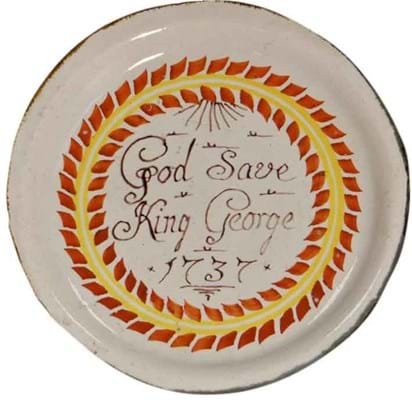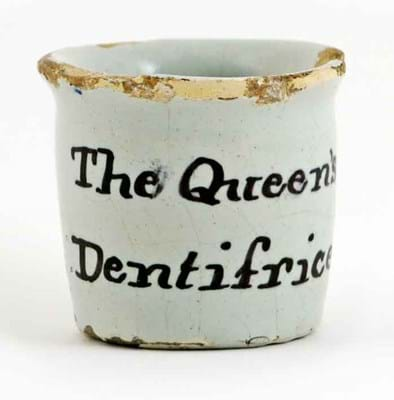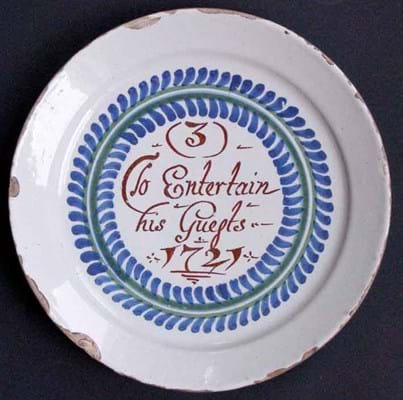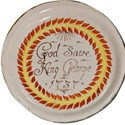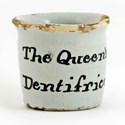The previous year, a satirical notice had been pinned to the gates of St James's Palace decrying his absence in Hanover - it read Lost or strayed out of this house a man who has left a wife and six children on the parish - and by January gossip was sweeping London that he had drowned in a shipwreck.
His troubled relationship with his son and heir apparent Frederick did not help: upon his arrival in London (very much alive but with a fever and piles), the cash-strapped Prince of Wales put it about that the king was dying. Soon after George banished him and his family from the royal court, Queen Caroline died and to the surprise of many George displayed "a tenderness of which the world thought him before utterly incapable".
It was doubtless in this climate that the rare tin-glazed pottery plate discovered by Cardiff auctioneer Rogers Jones (20% buyer's premium) in a stone farmhouse in the uplands of South Wales was created.
Within a double line yellow border bounded on two sides by a red-dash pattern, it carried the simple motto of support God Save King George 1737.
A similar 9in (22cm) plate is in the V&A collection, part of the Alfred Williams Hearn bequest, and attributed to Bristol. Surviving in near-perfect condition within a Victorian felt-covered frame, this recent find was estimated at £2800-3500 but on May 30 sold to a specialist ceramics dealer for £5400.
From the same source, another Bristol delft plate of similar date, decorated in brown, ochre and green with a cloaked figure in a landscape of sponged trees, sold to the same buyer for £800. It had some substantial glaze loss to the rim.
Meanwhile, the sale of English and Continental Ceramics and Glass at Woolley & Wallis (22% buyer's premium) of Salisbury on May 7 included a rare English delftware ointment pot c.1775 painted in manganese with The Queen's Dentifrice.
The inscription was probably a reference to Jacob Hemet, the third generation of a family of Huguenot dental practitioners, who was made Operator for the Teeth to Queen Charlotte in 1766 - an appointment that was subsequently extended to other members of the royal family.
Like many other practising dentists of the time, Hemet concocted his own mouthwashes and dentifrices but was unusual in taking the trouble to patent them - advertising Hemet's Essence of Pearl or Pearl Dentifrice in a range of London and provincial newspapers. He even travelled to America in 1772 to promote his wares.
Appealing to a variety of collectors, jars such as this 2in (5cm) example provide one of the livelier niches within the delft marketplace. Estimated at £800-1200, it sold to a private buyer at £1700.
Another medical-related delftware lot at the Salisbury sale was a Liverpool apothecary or pill slab from the second half of the 18th century. Of octagonal form, 11in (27cm) across, it was painted in blue with the arms of the Worshipful Society of Apothecaries with the motto Opiferque Per Orbem Dico picked out in manganese. In decent condition, it too went over hopes at £3600 selling to a trade buyer.
Merryman Plates
Delft Merryman plates, made in sets of six with each carrying a line from a once famous verse*, were made as early as the 1680s and as late as the 1750s. But most fall between c.1715 and c.1740 such as the example sold by Michael Bowman (17.5% buyer's premium) at the Chudleigh Town Hall, Devon, on May 10.
This and another delft plate came to sale from the home of a local lady going into residential care - the only items in her house that were of interest to the auctioneers.
Carrying the third line of the series To Entertain His Guests, it is also dated 1721 - a real bonus to its commercial fortunes. In relative good condition, it went to a London telephone bidder at £2800, well above the modest estimate of £200-300.
* When all six plates are assembled in order, they read: What is a merry man, Let him do what he can, To entertain his guests, With wine and merry jests, But if his wife do frown, All merriment goes down.


